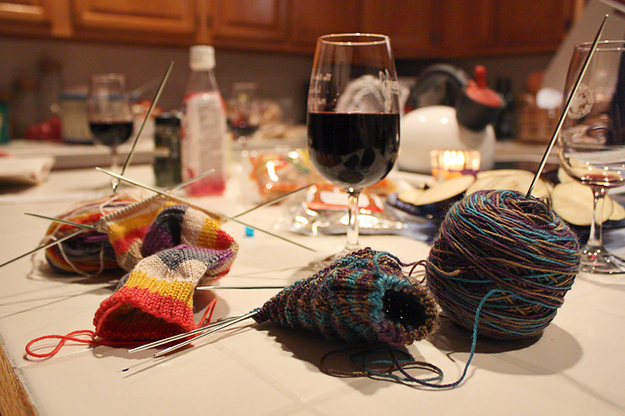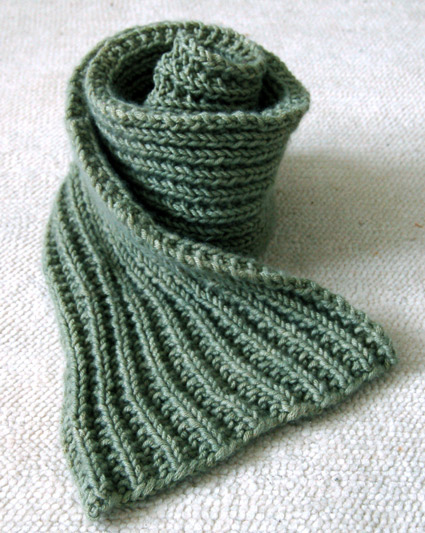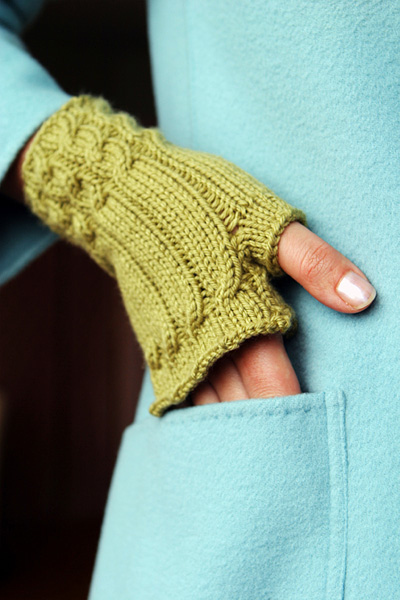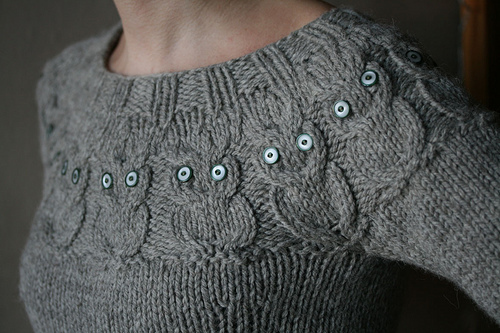Fact: knitting is the best.

You can knit literally anything you want.
It gives you something to do while in transit.

It's relaxing.

And you'll never need to buy clothes or gifts ever again.

Here's how to start knitting in just a few easy steps.
ALL THIS WILL SOON BE YOURS.

The first thing you have to do is get the stitches on the needle. There are plenty of different methods for casting on; this one is called "long-tail." If you'd like to find a different way, backward loop is very easy to learn (although it can be tough to knit from) and the cable cast on is very similar to the knit stitch (it produces a much less stretchy edge than long-tail). Do whatever makes you happy!
Step One: Tie a slip knot.
Create a loop and draw a second loop up through the center, tugging the loose end of yarn to tighten. Leave a long enough "tail" of yarn to make the number of stitches you'll need; a good rule of thumb is to try wrapping the yarn around the needle, so if you want to cast on 30 stitches, wrap the yarn 30 times (leave a little extra for error).
Step Two: Slip the knot onto a needle.
Pull the yarn so it's snug (but not too tight). Open up the yarn with your thumb and forefinger so that it makes a diamond-shape, holding the ends in your remaining fingers.
Step Three: Draw the tip of the needle over, around and through the yarn, creating a stitch.
Bring the tip of the needle up through the loop of yarn around your thumb, down through the loop around your index finger, and back through the loop around your thumb, slipping the newly-created stitch from your thumb to the needle. Open the yarn back up into the diamond and repeat until you have the number of stitches you want.

This is the most basic stitch you can learn; it creates the pattern that you probably think of when you think of "knitting." You can pretty much make anything you want with this stitch.
Insert the tip of the right needle through the first stitch on the left needle, front to back. Make sure that the yarn you're knitting with is behind the needles, not in front. With your right hand, wrap the yarn under and around the tip of the right needle. Carefully pull the tip of the right needle forward through the old stitch, "trapping" the new loop of yarn; let the old stitch slide off the left needle.

This is essentially the opposite of knitting; you can use it on the reverse side from the knit stitch to create a uniform look, or alternate the two to make all kinds of patterns.
With the yarn held in front of your knitting, insert the tip of the right needle through the first stich on the left needle, back to front. Wrap the yarn over and around the tip of the right needle. Pull the tip of the right needle back through the old stitch, trapping the new loop of yarn and allowing the old stitch to slide off the left needle.

This is how you finish a piece of knitting so that the stitches won't unravel. Like casting on, there are plenty of methods; just find the one that works best for you.
Step One: Knit the first two stitches of a row.
You might want to make them a little looser than usual, so that the cast-off edge is stretchy.
Step Two: Pass the first stitch over the second.
Repeat across the row.
Step Three: When you're down to the last stitch, pull it through.
Cut the loop, leaving enough yarn to sew in the end (this is called "weaving in"). Thread the end through a tapestry needle and sew it through a few edge stitches, cutting the remaining yarn so that it doesn't poke out from the fabric. CONGRATS, YOU'RE PERFECT.

Some knitting projects require you to sew several different pieces of knitting together. Depending on what type of pieces you're seaming, you'll have to do it different ways, but this is the most basic.
Match each edge of the piece and sew underneath the "v" of each knit stitch for an even, invisible seam.

Here's an easy project for beginners: a sweater for your phone.
View this video on YouTube

To make the case, cast on 14 stitches — this particular case is for an iPhone 4S, so you may need to add or subtract a couple stitches if your phone/iPad/deck of cards/whatever you're making a cozy for has a different width.
Knit one row (this is called the right side), then purl the next (the wrong side). Repeat these two rows until your knitting measures twice as long as your device.
Cast off on a wrong-side row. Fold the fabric so that the wrong side faces outward and seam up each of the two long sides. Turn the case inside-out, and voila! Your phone will never be chilly again.

If you'd prefer an easier project with no seaming, you can stop halfway and make a bow.

It can function as a hair accessory, bow tie, gift topper, or any of the other myriad things you can do with a bow in our modern society.
To make this, follow the above instructions (casting on, alternating between knit and purl rows) for about 3 to 3.5 inches. Cast off and weave in ends. Cinch the middle and wrap a spare piece of yarn around it; tie the ends and snip them. This is another great bow pattern that's a bit more involved.
Want to try something a little bigger? This scarf is super easy, fast, and looks fantastic.

Get the pattern from The Purl Bee, which is chock full of incredible patterns (they also feature sewing, needlepoint, crochet, and tons-of-other-crafts-besides-knitting patterns).
And even bigger: this super-chunky blanket.

Knit with thick yarn on size 17 needles, you'll have an amazing gift that looks like it took you a year to make. Also from The Purl Bee.
These fingerless mitts are a great way to try knitting on double-pointed needles and cabling.

Both skills look intimidating but aren't nearly as difficult as they appear. Check the pattern out on Knitty, another invaluable resource for patterns and knitting tips.
And when you're ready to tackle a sweater, this owl pattern is the cutest, easiest knit.



